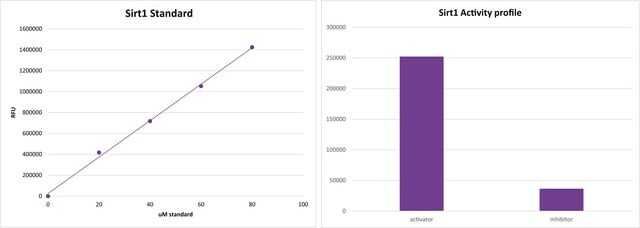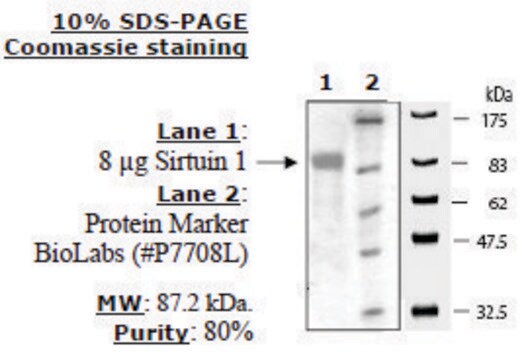S8446
SIRT1 Peptide
≥90% (SDS-PAGE), human recombinant, expressed in E. coli, N-terminal histidine tagged
Synonym(s):
SIR2α, SIR2L1, Sirtuin1
Sign Into View Organizational & Contract Pricing
All Photos(1)
About This Item
Recommended Products
Product Name
SIRT1 human, recombinant, expressed in E. coli, N-terminal histidine tagged, ≥90% (SDS-PAGE), buffered aqueous glycerol solution
recombinant
expressed in E. coli
Quality Level
description
full-length amino acid sequence of original SIRT1 protein (accession number NP_036370)
Assay
≥90% (SDS-PAGE)
form
buffered aqueous glycerol solution
UniProt accession no.
shipped in
dry ice
storage temp.
−20°C
Gene Information
human ... SIRT1(23411)
General description
SIRT1 (sirtuin 1) belongs to the silent information regulator (SIR) family and is a class of HDAC (histone deacetylase). It is expressed in various tissues including brain, liver, pancreas, adipose tissue, and skeletal muscle. SIRT1 is also known as the longevity gene.
Application
Human SIRT1 (sirtuin1) has been used in in vitro acetylation and deacetylation assays. It has also been used to study its effects on homeostasis of human nucleus pulposus cells.
Biochem/physiol Actions
SIRT1 (sirtuin 1) functions as a regulator of various metabolic pathways, and influences the pathophysiology of several metabolic diseases. It is a regulator of protein deacetylation, and is a candidate therapeutic target in non-alcoholic fatty liver disease (NAFLD), amyotrophic lateral sclerosis (ALS), kidney disease, and pulmonary disease. It also participates in tumorigenesis, and whether it functions as an oncogene or as a tumor suppressor depends upon the tumor type. In pancreatic ductal adenocarcinoma (PDAC) its elevated expression is linked with poor prognosis, and in non-small-cell lung cancer (NSCLC) it suppresses the expression of tumor suppressor p27. It is also thought to function as a suppressor of cardiovascular disorders, such as myocardial infarction, or neurodegenerative diseases, such as Alzheimer′s disease (AD) or Parkinson′s disorder (PD).
Sirtuins are a family of NAD+ dependent deacetylases that remove an acetyl group from the e-amino group of lysine residues. The proteins within this family are named after the first protein discovered, from yeast, called Sir2 (Silent Information Regulator 2). The proteins are conserved from bacteria to higher eukaryotes. In humans, there are seven Sir2 family members (SIRT1 to SITR7). SIRT1 plays a pivotal role in the regulation of cellular differentiation, metabolism, cell cycle, apoptosis and regulation of p53. Several targets for SIRT1 were identified among them Lys382 of p53. Using RNA interference, additional targets were identified. It was demonstrated that reduced levels of human SIRT1 led to increased acetylation of Histone H4-Lys16, H4-Lys20, and Histone H3-Lys9 as well as histone H1-Lys26.
Physical form
Solution containing 50 mM Tris, pH 7.4, 100 mM NaCl, 1 mM DTT, protease inhibitors (Product code P8340) 1:200, and 10% glycerol (w/v).
related product
Product No.
Description
Pricing
Storage Class Code
12 - Non Combustible Liquids
WGK
WGK 1
Flash Point(F)
Not applicable
Flash Point(C)
Not applicable
Choose from one of the most recent versions:
Already Own This Product?
Find documentation for the products that you have recently purchased in the Document Library.
Modulations of hMOF autoacetylation by SIRT1 regulate hMOF recruitment and activities on the chromatin
Lu Lu
Cell Research (2011)
Expression of silent mating type information regulator 2 homolog 1 and its role in human intervertebral disc cell homeostasis
Arthritis Research & Therapy (2011)
Yeon-Hwa Lee et al.
Cancer letters, 431, 219-229 (2018-05-29)
SIRT1, an NAD+-dependent histone/protein deacetylase, has diverse physiological actions. Recent studies have demonstrated that SIRT1 is overexpressed in colorectal cancer, suggesting its oncogenic potential. However, the molecular mechanisms by which overexpressed SIRT1 induces the progression of colorectal cancer and its
Taek-Yeol Jung et al.
Experimental & molecular medicine, 52(7), 1075-1089 (2020-07-09)
Histidine triad nucleotide-binding protein 1 (HINT1), which belongs to the evolutionarily conserved HIT superfamily, has been shown to possess a tumor-suppressive function by binding to and inhibiting several oncogenic transcription factors, such as β-catenin and microphthalmia transcription factor (MITF), in
SIRT 1 Overexpression is Associated with Metastasis of Pancreatic Ductal Adenocarcinoma (PDAC) and Promotes Migration and Growth of PDAC Cells.
Li S
Medical Science Monitor : International Medical Journal of Experimental and Clinical Research, 22 (2016)
Our team of scientists has experience in all areas of research including Life Science, Material Science, Chemical Synthesis, Chromatography, Analytical and many others.
Contact Technical Service








